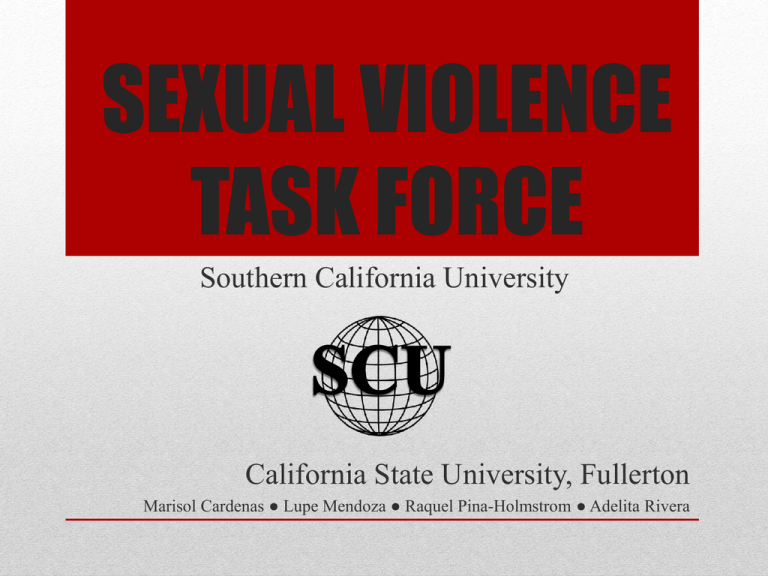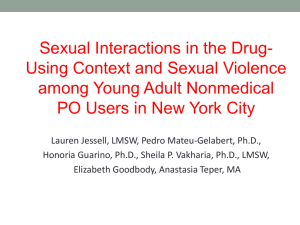
SEXUAL VIOLENCE
TASK FORCE
Southern California University
California State University, Fullerton
Marisol Cardenas ● Lupe Mendoza ● Raquel Pina-Holmstrom ● Adelita Rivera
Outline
Introduction
Definitions
History
Statistics
Goals & Learning Outcomes
• Theory
Sexual Violence Response and Prevention Center
Changing the Culture
Policy
Guidelines
Crisis Management Cycle
Social Media
Introduction
With the nationwide increase of rates in sexual violence on
college campuses, Southern California University (SCU) has
committed to supporting and empowering survivors of sexual
violence, while educating and encouraging bystanders to take an
active role in preventing sexual violence on campus.
The Sexual Violence Response and Prevention Center (SVRPC)
is our response to assisting survivors, promoting awareness, and
ensuring the prevention of sexual violence at CSU. SVRPC will
follow a five-phase crisis management model as a continuous
process of learning for everyone on campus.
The Center will provide facts, strategies, and resources to
encourage dialogue between everyone on campus and assist in
the prevention of sexual violence. We are committed to
enhancing advocacy on campus and promoting a safe campus
for everyone.
Definitions
Consent: A free of coercion explicit agreement between
individuals to involve in sexual activity, based on full awareness,
mental ability and maturity of the individuals involved.
Sexual Violence: The forcing of another person to engage in any
sexual activity through the use of intimidation and the explicit or
implicit threat of further violence if one’s advances are refused.
For many men sexual violence occurs as a result of sexual jealousy.
(Rainbow Services, 2011)
HISTORY
Rates of sexual violence among college students are higher
than national rates (Garcia, 2012). Sexual violence such as
rape in early America was based on “racial hierarchies”
(Block, 2006). Today, we know that sexual violence is a
practice that continues to happen in society regardless of
gender, social class, or ethnicity.
According to Kendall (2010) acquaintance rape on college
campuses “takes the form of gang or party rape” (p. 181). As
student affairs professionals we need to take an active role in
promoting student learning and development (American
College Personnel Association, 1996), including addressing
and preventing sexual violence on campus.
Student affairs professionals face the challenge of
implementing services and programs for everyone on campus
to educate and create a violence-free, safe environment for all.
Statistics
According to NISVS (2010) report:
Females compose the vast majority of sexual violence
victims with nearly 1 in 5 females being raped during their
lifetime, with 92% of the victims knowing their perpetrator.
Males are also at risk with 1 in 71 males reporting been raped
during their lifetime, with 85% of the victims knowing their
perpetrator.
Most perpetrators are male, with over 90% of both female
and male survivors identifying their perpetrator as male.
Goals & Learning Outcomes
The goal of the Sexual Violence Task Force is to develop campus
services, programs, and procedures to achieve the following
learning outcomes:
1. PWiBAT define sexual consent and locate support
resources on and off campus for survivors.
2. PWiBAT differentiate facts of sexual violence from myths.
3. PWiBAT identify accuser characteristics and recognize the
legal implications and proceedings for the accuser.
4. PWiBAT formulate and analyze new approaches to
support sexual violence survivors.
5. PWiBAT identify and analyze bystander approaches to
intervene and advocate when witnessing sexual violence
misconduct.
Kolb
The first learning outcome educates participants on definitions of
sexual consent and provides resources offered on and off campus. This
is an application of Kolb’ (1984) theory of experiential learning. The
events designed by the task force aims to move participants from
understanding to advocating through concrete experience, reflective
observation, abstract conceptualization, and active experimentation.
King &
Kitchener
Implementation of Theory
The second learning outcome addresses stereotypes and/or biases we
know about sexual violence. Participants will reflect on the facts about
sexual violence on campus. This outcome addresses King &
Kitchener’s (1994) quasi-reflective thinking where participants are
challenged to look past the socially constructed stereotypes and myths
about sexual violence. The task force committee aims to provide
multiple opportunities for participants to recognize the facts about
sexual violence through sexual violence awareness week and other
events held on and off campus.
(Evans et al., 2010)
Perry
Berkowitz &
Bronfenbrenner Marcia
The third learning outcome adopts Perry’s (1981) theory of intellectual and
ethical development. The goal is for participants to identify characteristics
of sexual violence offenders. Individuals will move from a dualistic stage
where meaning making is viewed dichotomously to a commitment position
where individuals will understand multiple characteristics and ensure rights
of those accused of sexual violence.
The fourth learning outcome is based on Marcia’s (1980) theory on ego
identity. Participants will formulate and analyze approaches that moves
them from a foreclosure status to an achieved status, resulting in a shift in
paradigm regarding sexual violence on campus.
The fifth learning outcome addresses different approaches on how campus
community members can be part of a campus culture that promotes
awareness and advocacy of sexual violence. Berkowitz (2005) social
norms research on “pluralistic ignorance” shows that bystanders
incorrectly perceive attitudes and behaviors of peers and other individuals
engaging in unhealthy behaviors. Utilizing Bronfenbrenner’s (1989)
ecological systems theory we can inform participants on the role
bystanders play in society and educate them on the importance of taking an
active role in the prevention of sexual violence on campus.
(Evans et al., 2010)
Sexual Violence Response
& Prevention Center
SVRPC aligns with the mission of SCU in its commitment to
social justice and advocacy and in promoting a supportive
learning environment for all on and off campus. Through
adopting a five-phase crisis management multi-faceted approach
that focuses on a continuous process of learning for everyone on
campus, SVRPC intents to create a practical preventive protocol,
provide education on sexual violence and related issues, and act
as an agent to empower and inspire advocates to social justice.
Through services, programs, and events offered on campus and
through social media, we will assist survivors, promote
awareness, and ensure the prevention of sexual violence at CSU.
Crisis Management Cycle
The SVRPC model ensures a
continuous process of learning in
crisis management on campus.
The model includes five-phases:
1.
2.
3.
4.
5.
Prevention & Mitigation
Planning
Response
Recovery
Learning
Adapted from Harper, Paterson & Zdziarski, 2006)
Prevention & Mitigation
Step 1
•
•
•
•
•
•
•
•
•
Sexual Violence Response and Prevention Center (SVRPC)
Sexual Violence Awareness Week (April 1-5)
Sexual Violence 101 for students, staff, and faculty
Faculty and Staff Sexual Violence Ally Training
Bystander Intervention Ally Training
SVRPC website
End the Cycle of Silence Facebook page
End the Cycle of Silence Twitter page
Cultural Competency Training
Planning
Step 2
•
•
•
•
•
Southern California University Clery Report
Sexual Violence Task Force
Partnerships between the university and the community
Collaboration between different entities at the university
Stakeholders: students, survivors, staff, faculty, campus
clubs and organizations, shelters and prevention centers
in the community, campus police and community law
enforcement and the community
Response
Step 3
•
•
•
•
•
•
•
•
•
•
•
“Bring back the night”
“Sole Survivor” display
Teal Ribbon Campaign
Vagina Monologues
Survivor Speaker Nights
Campus Forum open to the community
24 Hour Hotline
Emergency crisis shelter in the community
SVRPC website
End of Cycle of Silence Facebook page
End of the Cycle Twitter page
Recovery
Step 4
• Counseling and Psychological Services (CAPS)
• Campus and community survivor focus groups
• Individual and group counseling services for survivors and
those accused of sexual violence
• Education groups for survivors and those accused of sexual
violence
• Support groups that may include the survivors and those
accused of sexual violence support systems.
Learning
Step 5
• Assessment of learning outcomes of programs, services, and
events
• Campus-wide surveys
• Overall evaluation of the center
• Identifying best practices of programs, services, and events
offered on campus.
• Strengthen partnerships with the local community.
• Strengthen the collaboration between different entities at the
university
Changing the Culture
The Sexual Violence Task Force also recognizes that SVRPC can
promote change in the campus culture of SCU through…
Education- the truth about sexual violence will replace the myth
that is so prevalent in our campus culture and society. Victim
blaming needs to come to a stop.
Peer educators can challenge the college culture that tolerates
rape by partnering with the SVRPC to present workshops on
community values and educating students on how to be active
bystanders. Safety and respect are vital to make this change.
A climate survey is important in seeing the bigger picture of how
students feel and what they need in order to feel safe on campus.
Assessment of current policies and practice can aid in providing a
safer environment for our students.
Campus policies need to be reviewed and updated to ensure
university, administrators, faculty, and staff have the means to
properly handle a crisis situation.
Policy Revisions
The following are areas that would require SCU policies
regarding sexual violence to be implemented and/or updated.
• Study Abroad or Joint Programs: To ensure the safety of our
students abroad, partnering institution need to be equipped to
provide the support and resources students need in the case of a
sexual violence crime. As the primary institution, survivors
need to be aware that we will advocate for them on their
arrival.
• Amnesty Policy: Survivors should be able to report sexual
violence without the fear of castigation due to a possible
student conduct violation (i.e. alcohol) or fear of documented
status being revealed.
• Student Health Services should be able to provide Rape Kits
to survivors so that if at any point they would like to prosecute
they can have that option.
Guidelines
SCU is dedicated to enacting a sexual assault policy that
students should be aware of.
• Students need to know that if they have been sexually
assaulted it is not their fault. They need to be assured that
there is help readily accessible.
• Students have the option to report a sexual assault to law
enforcement. Contact information should be readily
accessible.
• Students should be encouraged to seek medical attention.
Campus resources should be readily accessible.
• Finally, students should be given time for their wellbeing. Students need to be informed that it is never to
late to seek help.
Website
Social Media
Twitter: Follow us @taskforce2014
Facebook page: Visit us at
https://www.facebook.com/task.force.144734
References
Council for the Advancement of Standards in Higher Education.
(2012). CAS professional standards for higher education (8th
ed.). Washington: DC: CAS Publications.
Evans, N. J., Forney, D. S., Guido, F. M., Patton, L. D., & Renn,
K. A. (2010). Student development in college: Theory, research,
and practice (2nd ed.). San Francisco: Jossey-Bass.
Kendall, D. (2010). Social Problems in a diverse society (5th
ed.). Boston, MA: Pearson.
Whitmer, B. (1997). The violence mythos. Albany, NY: State
University of New York Press.







